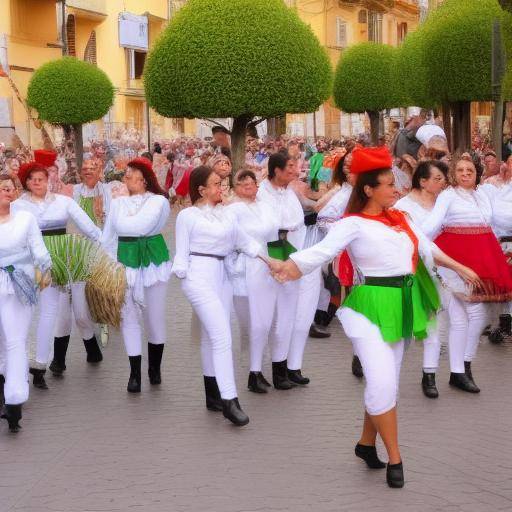
La Tomatina de Buñol is a unique festival in Spain that has gained international fame due to its extravagance, fun and rooted tradition. In this article, we will explore the history, cultural significance, and the evolution of this iconic event, together with a detailed analysis of the city of Buñol and the wealth of festivals in Spain. We will also provide practical advice, expert opinions and future trends related to these exceptional celebrations.
Introduction
The Tomatina de Buñol is an annual festival that attracts visitors from around the world to the small town of Buñol, located in the Valencian Community of Spain. This event, which dates back to the last week of August 1945, has become an emblematic celebration that combines the Spanish festive spirit with a dose of chaotic fun. This exciting festival has become famous for its colorful and joyful tomato disorder, creating an unparalleled experience that attracts enthusiasts of all ages.
In this exhaustive article, we will examine the fascinating history behind La Tomatina, explore the city of Buñol, its cultural charm and its tourist attractions, and immerse ourselves in the wealth of Spanish festivals, which are a vital part of the identity and the festive spirit of the country.
History and Background
The history of La Tomatina dates back to a dispute in the Buñol market in 1945, when a group of young people, excited by the possibility of joining a parade, began to throw tomatoes at each other. Although the police intervened to stop the riot, this unexpected kingship laid the foundations for what would later become a popular annual event.
Over the years, La Tomatina has evolved through periods of prohibition and resurgence. In 1957, the City of Buñol took control of the festival, making it an official event, and since then it has become a highlight of the Spanish tourist calendar.
The evolution of La Tomatina reflects the unique capacity of a simple conflict to unite people into a collective celebration, turning an isolated incident into a lasting symbol of fun and camaraderie.
Analysis in Deep
The festival of La Tomatina has proved to be an inexhaustible source of benefits, both for the city of Buñol and for the Spanish tourist industry. It is a major attraction for international visitors, generating significant momentum for the local and regional economy. In addition, the festival has won recognition as an important cultural event, highlighting the tradition and folklore of Spain worldwide.
Despite its benefits, La Tomatina faces unique challenges, such as waste management and participant security. However, local authorities have demonstrated a remarkable ability to mitigate these challenges, ensuring that the festival remains a safe and exciting experience for all involved.
Exhaustive examination
The city of Buñol, located in the province of Valencia, is more than the host of La Tomatina. This charming city offers a unique blend of history, culture and natural attractions that make it a must-see destination for travellers who seek to immerse themselves in the authentic Spanish experience.
Buñol is known for its architectural legacy, which includes centuries-old churches, picturesque squares and cobbled streets that narrate the rich and diverse history of the region. Visitors can enjoy the exquisite local cuisine, ranging from traditional dishes to modern delights that reflect the fusion of flavours of the region.
In addition, Buñol is the ideal setting to experience the lively festive culture of Spain, with numerous celebrations and events throughout the year that show the passion and festive character of its residents. The warm and welcoming hospitality of the people of Buñol adds a special touch to the experience, leaving a lasting impression on those who visit it.
The wealth of Spanish festivals is a testimony to the cultural diversity and vibrant tradition of the country. From religious celebrations to folklore events and gastronomic festivals, Spain offers an impressive range of festive experiences that reflect the rich history and unique identity of each region.
Comparative analysis
When comparing Tomatina, Buñol and Spanish festivals in general, significant similarities and differences are revealed. While La Tomatina stands out for its uniqueness and thematic focus, the Spanish festivals as a whole represent the cultural diversity and wealth of the country's heritage. Buñol, with its captivating charm and festive spirit, serves as a microcosm of Spanish festive diversity, merging the traditional with the contemporary in a vibrant celebration.
Practical Tips and Accessible Tips
If you plan to attend La Tomatina or explore the Spanish festivals, here are some practical tips to make the most of your experience:
- Come early and get ready for an exciting experience
- Protect your belongings with waterproof bags and proper clothing
- Prepare your camera to capture unforgettable moments
- Take the opportunity to explore local culture and gastronomy
- Learn about logistics and safety precautions before attending
Industry Perspectives and Expert Reviews
According to tourism and culture experts, La Tomatina and Spanish festivals play a crucial role in promoting cultural tourism and preserving local traditions. These emblematic events offer a unique opportunity for visitors to immerse themselves in the authenticity of Spanish culture, creating unforgettable experiences that transcend the conventional expectations of a journey.
Case Studies and Real Life Applications
The Spanish festivals, including La Tomatina, have demonstrated their ability to inspire creativity, foster innovation and strengthen community ties. Through educational programs, cultural activities and intersectoral collaborations, these events have a lasting impact on society, promoting intercultural understanding and enriching the lives of those involved in them.
Future Trends and Predictions
As Spain continues to consolidate its reputation as a culturally enriching destination, it is expected that La Tomatina and other Spanish festivals will continue to evolve to adapt to the changing demands of modern travelers. It is anticipated that innovation, sustainability and the supply of authentic experiences will remain key areas of focus, ensuring that these celebrations continue to captivate future generations.
Conclusions and FAQs
In conclusion, La Tomatina de Buñol, together with the city of Buñol and the Spanish festivals, embody the vitality, tradition and passion that distinguish Spain as a culturally diverse and exciting destination. These intrepid celebrations encapsulate the very essence of the Spanish festive spirit, offering unique experiences that remain in the memory of those who live them.
Frequently asked questions
What is the exact origin of the Buñol Tomato?
The Buñol Tomatina has its roots in a spontaneous incident in the local market in 1945, which evolved into an official annual festival over the years.
Why does Tomatina attract so many international visitors?
The Tomatina has gained international fame due to its extravagance, fun and the uniqueness of throwing tomatoes, creating an unparalleled experience that attracts enthusiasts of all ages.
How does La Tomatina contribute to tourism in Buñol and Spain?
The Tomatina is an important driver of tourism in Buñol and Spain, attracting a large influx of international visitors that generate a significant impact on the local and regional economy.
What other holidays can be enjoyed in Buñol as well as La Tomatina?
Buñol hosts a variety of festivals throughout the year, ranging from traditional religious events to gastronomic and cultural celebrations that offer a diverse view of local life and rooted traditions.
What is the importance of Spanish festivals in promoting culture and tourism?
Spanish festivals play a crucial role in promoting cultural tourism and preserving local traditions, offering authentic experiences that attract travelers from around the world.
What steps are taken to ensure security and sustainability during La Tomatina?
Local authorities implement security and sustainability measures, such as waste management and logistics planning, to ensure that La Tomatina is a safe and environmentally friendly experience.
What future trends are expected in the panorama of Spanish festivals?
It is anticipated that the Spanish festivals will evolve towards more innovative, sustainable and authentic approaches, in order to continue captivating current and future audiences with enriching and memorable experiences.
In short, La Tomatina de Buñol, Buñol and the Spanish festivals represent the very essence of the rich cultural and festive tradition of Spain. These vibrant celebrations offer a living testimony of the vitality and contagious spirit that characterize this unique country, ensuring unforgettable experiences for all who have the privilege to participate in them.



